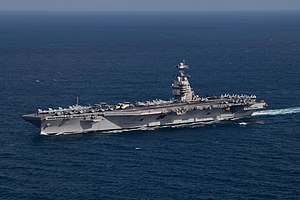Welf-class nuclear aircraft carrier: Difference between revisions
No edit summary |
|||
| Line 54: | Line 54: | ||
==Development== | ==Development== | ||
The search for a new and improved aircraft carrier design began as soon as the first Wilhelm-class was comissioned for service in 1980. By the early 1990s, the Khakus and Department of the Navy clearly saw that Drambenburgian Naval supremacy had faltered. The introduction of the prohibitively expensive Lange-class battleship remedied that momentarily; however, by the mid-2000s, other nations had developed better aircraft and missiles, reducing the effectiveness of Drambenburg's navy further. In 2006 the Department of the Navy began the Advanced Naval Air Superiority Program (ANASP) which led to the development of the [[P-51 Osprey (Drambenburg)|P-51 Osprey]] and the Welf-class nuclear aircraft carrier. | The search for a new and improved aircraft carrier design began as soon as the first Wilhelm-class was comissioned for service in 1980. By the early 1990s, the Khakus and Department of the Navy clearly saw that Drambenburgian Naval supremacy had faltered. The introduction of the prohibitively expensive Lange-class battleship remedied that momentarily; however, by the mid-2000s, other nations had developed better aircraft and missiles, reducing the effectiveness of Drambenburg's navy further. In 2006 the Department of the Navy began the Advanced Naval Air Superiority Program (ANASP) which led to the development of the [[P-51 "Osprey" (Drambenburg)|P-51 Osprey]] and the Welf-class nuclear aircraft carrier. | ||
===Planning=== | ===Planning=== | ||
Latest revision as of 23:39, 25 May 2023
 SMS Welf underway in the Cantalle Ocean on 9 October 2022.
| |
| General characteristics | |
|---|---|
| Class and type: | Welf-class |
| Length: | 1,092 ft (333 m) |
| Beam: |
|
| Height: | 250 ft (76 m) |
| Decks: | 25 |
| Propulsion: | Four shafts |
| Speed: | In excess of 30 knots (56 km/h; 35 mph) |
| Range: | ≈25 years before mid-life refuel |
| Complement: | 4539 (including air wing) |
| Armament: |
|
| Aircraft carried: | 75+ |
| Aviation facilities: | 1,092 ft × 256 ft (333 m × 78 m) flight deck |
The Welf-class nuclear aircraft carrier is a class of nuclear powered aircraft carriers currently being constructed for the Drambenburgian Kreigsmarine. The class, with two in active service and a planned total of four ships, is planned to add to the Navy's current carriers, the Wilhelm-class. The new vessels have a hull similar to the Wilhelm-class but introduce technologies such as the Electromagnetic Aircraft Launch System (EMALS), a second launch deck, a dedicated helipad, improved efficiency reactors, as well as other design features intended to improve efficiency and reduce operating costs, including sailing with smaller crews. The Welf-class is the world's largest aircraft carrier, surpassing the Talon-class nuclear aircraft carriers. The class of aircraft carriers is named after Erich Ramira von Welf who served as an admiral in the Drambenburgian Navy from 1880 until 1888 when he was elected Kaiser of Drambenburg. The second ship SMS Arminjon was comissioned April 18th, 2023.
Design features
Design features of the Welf-class include:
- Advanced arresting gear (AAG)
- Advanced automation, robotics, and state-of-the-art Artificial Intelligence (AI) allowing a crew of several hundred less than the Wilhelm-class cariers.
- Updated anti-aircraft-and-missile missiles
- Multifunction dual-band RADAR
- Electromagnetic Aircraft Launch System (EMALS) replacing outdated steam catapults from older aircraft cariers
- State of the art nuclear ractors and steam turbines, initially designed to power the Lange-class battleships' railguns
- Reduced RADAR cross-section
- Ability to carry up to 200 aircraft, typically 90, depending on configuration
The largest visible difference from older iterations of aircraft cariers is the aftward movement of the superstructure. Due to the smaller acompanyment, the lifetime cost for the Welf-class is greatly reduced compared to the Wilhelm-class.
Development
The search for a new and improved aircraft carrier design began as soon as the first Wilhelm-class was comissioned for service in 1980. By the early 1990s, the Khakus and Department of the Navy clearly saw that Drambenburgian Naval supremacy had faltered. The introduction of the prohibitively expensive Lange-class battleship remedied that momentarily; however, by the mid-2000s, other nations had developed better aircraft and missiles, reducing the effectiveness of Drambenburg's navy further. In 2006 the Department of the Navy began the Advanced Naval Air Superiority Program (ANASP) which led to the development of the P-51 Osprey and the Welf-class nuclear aircraft carrier.
Planning
The goal of the ANASP was to create a multi-role air-superiority fighter jet with Short Takeoff and Landing (STOL) capabilities and a state-of-the-art aircraft carrier to launch it from. Requirements of the program were to have a smaller crew, larger capacity, and advanced technology never before seen on the seas. Herzog Manufacturing's Aerospace division won the aircraft program with the X-51 Joint Strike Fighter, and Herzog Manufacturing's Ship and Boat division won the aircraft carrier contract with their ANC-2 design. Using knowedge they gained from the design and building of the Lange-class destroyer, their prototype far surpased the competition in capability, technology, efficiency, and design.
Construction
Construction of the SMS Welf began in October, 2008, with the other three hulls being layed in 2010, 2020, and 2023. The SMS Welf hit several issues along the way, including a lack of raw materials to build several components on board, as well as a computer chip shortage which slowed the production significantly.